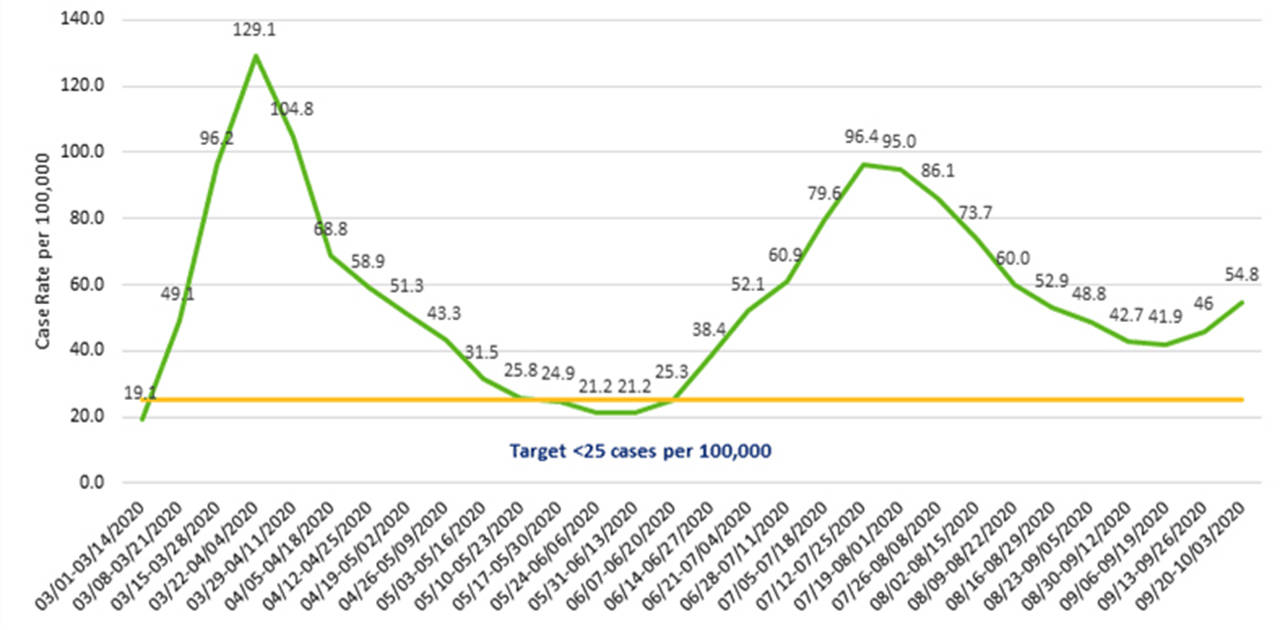OLYMPIA — Gov. Jay Inslee eased a slew of restrictions Tuesday that will allow dining indoors with friends, browsing book racks in libraries and getting served in bars a little bit later into the night.
The new rules, which come as coronavirus cases are on the rise statewide, will permit alcohol sales in bars and restaurants up to 11 p.m. in counties, like Snohomish, that are in Phase 2 of Inslee’s four-stage reopening plan. In addition, eateries will be able to seat as many as six at a table and a requirement they all be from the same household is being eliminated.
Other guidance issued Tuesday allows movie theaters and libraries to operate at 25% capacity for counties in the second phase with theaters moving to 50% capacity in the third phase.
And, the revisions will clear a path for a resumption of some high school sports and the return of real estate open houses for small numbers of people depending on a county’s stage of reopening.
“We wanted to do target things to show we can do things in a safe way,” Inslee said at an afternoon news conference.
Youth sports is an area with some notable changes. Whether a sport is allowed, and to what degree athletes can compete, depends on a combination of the risk category for the sport as listed in the guidance and the presence of COVID in the county in which it is to take place. The latter element is determined by the number of COVID cases per 100,000 residents in a two-week span.
For example, in counties with between 25 and 75 cases per 100,000, such as Snohomish, league games will be allowed for low risk sports of tennis, swimming, and track and field, and moderate risk sports of softball, baseball, soccer and volleyball. Scrimmages and intrasquad competitions for high risk sports like football are allowed too. In all instances no spectators are allowed.
The changes come amid an uptick in the number of coronavirus cases statewide. Inslee said he’s hoping the upward surge is temporary and a result of Labor Day gatherings and people spending more time indoors due to days of smoky skies. With those past, he’s counting on residents getting “back on track knocking the numbers down again.”
“We want to recognize the progress we’ve made. We want to celebrate it,” he said of the relaxed rules. “We think it’s the right thing to do because we have found the right way to do these things safely. “
Meanwhile in Snohomish County, COVID-19 cases are again on the rise.
After weeks of sustained success against the virus, the number of new infections every two weeks rose from 41.9 per 100,000 in September to 54.8 in the latest count, which ended Saturday. With back-to-back weeks of cases rising, local leaders are asking residents to double down on safety precautions to quell the potential third wave.
“We’ve done it before and we can do it again,” County Executive Dave Somers told reporters Tuesday.
The rise in infections could stem from people spending more time inside, with the recent stretch of smoky air, followed by colder temperatures and rain, Dr. Chris Spitters, the county’s top health officer said.
So, get a flu shot, wear a mask, maintain six feet of distance with non-household contacts, limit social gatherings, wash your hands and avoid touching your face, he said. If you’re indoors, crack windows when possible for better ventilation.
From Sept. 13 to Sept. 26, people ages 20 to 69 made up three quarters of all new infections, according to the latest health district report. Case counts for younger and older groups did not increase.
Nearly every area of the county is above the target case rate, with a heavy concentration of infections in cities along the I-5 corridor.
Additionally, none of the new cases have been linked to large gatherings.
“Although, human nature tends to be that they would not report engaging in a gathering that’s not permitted or discouraged,” Spitters said.
While a possible third wave of the virus is cause for concern, Spitters said, the hospitalization and death rates from the virus have remained flat, or even steadily dropped.
But things can change quickly, he said.
If infections shift to people in older age groups, who are more likely to experience complications from the virus, hospitals could become overwhelmed.
“It really is like driving on ice,” he said. “Once you realize you’re going too fast, it’s too late. We really are needing to tap on the brakes, in this, tapping on the breaks meaning those preventative measures.”
During the second wave of the virus, the number of people hospitalized by the virus got up to about 30. It’s now in the mid- to low-20s.
Meanwhile, some people experience side effects like heart inflammation after their bouts with COVID.
“What the long-term implications are, we don’t know,” Spitters said. “That’s just one example, what we’ve seen is a big deal, and in the long run, could be an even bigger deal than we understand.”
An Everett woman developed Bell’s palsy, a condition causing temporary weakening of muscles in the face, two months after testing positive for the virus.
Joey Thompson: 425-339-3449; jthompson@heraldnet.com. Twitter: @byjoeythompson.
Talk to us
> Give us your news tips.
> Send us a letter to the editor.
> More Herald contact information.

























